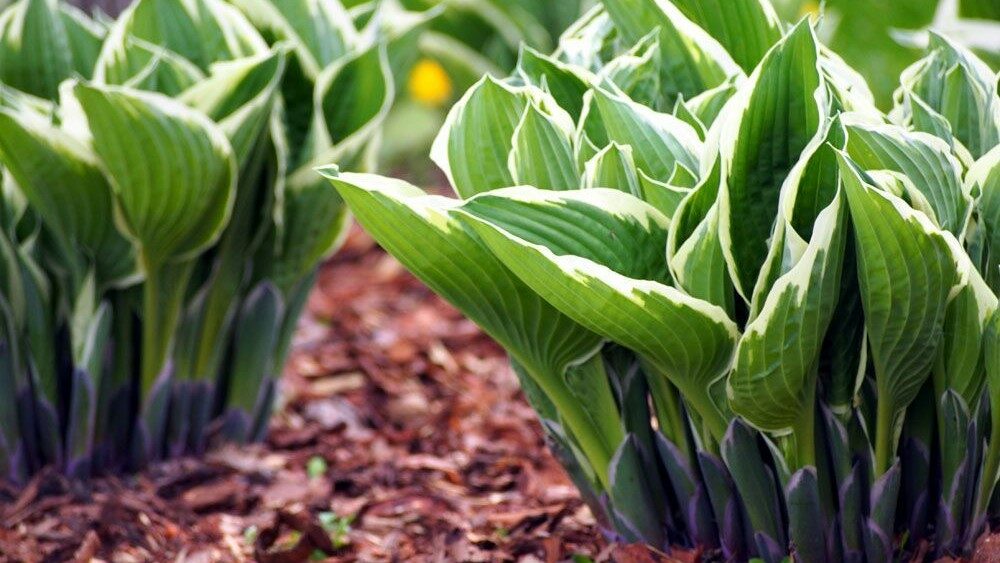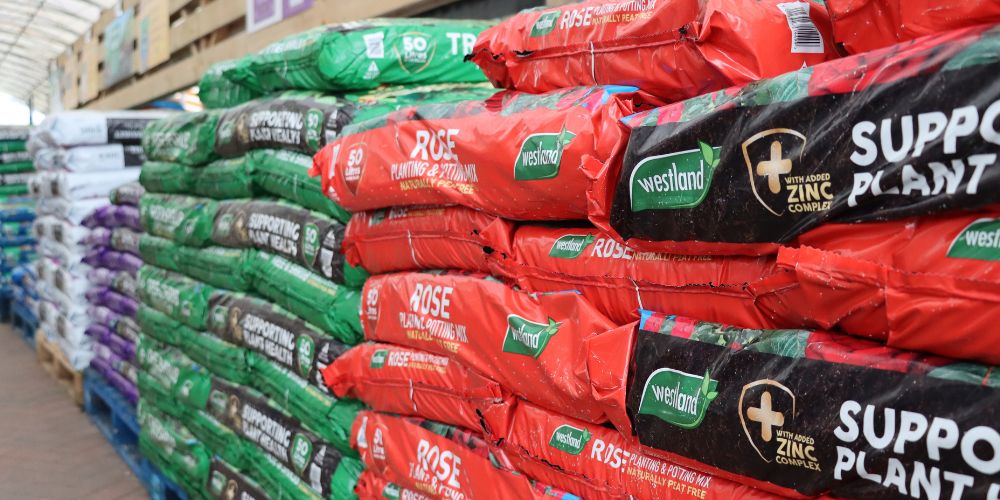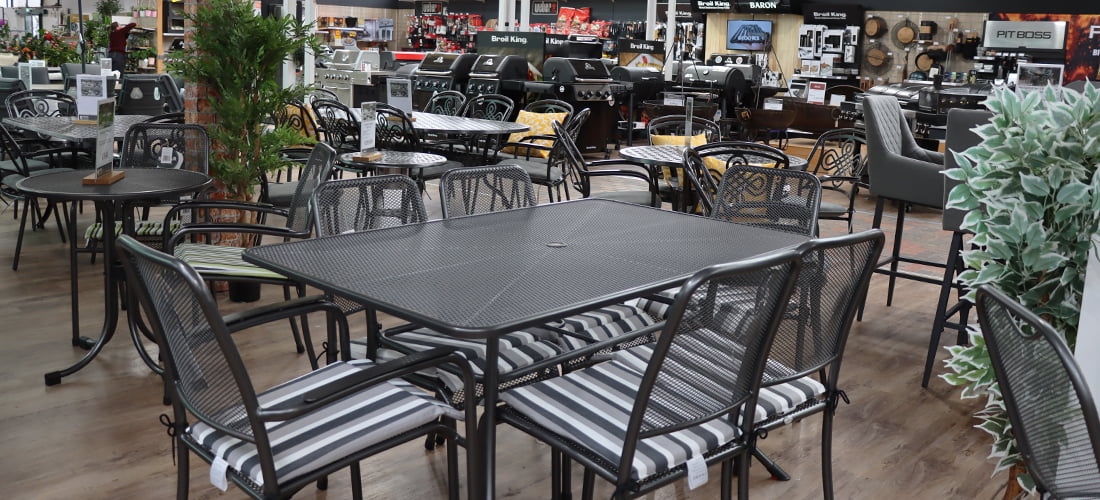If your soil is permanently moist either simply because of its nature or if drainage is obstructed, there are many attractive shrubs, trees and flowers which you can enjoy in your garden.
Even if you have quick drying soil like chalk, you can still enjoy a range of moisture lovers if you create a bog garden (using a butyl liner), pond or other water feature. These can really add interest and become a central point of any garden.
We sell a wide range of ponds, pumps, fountains and other aquatic equipment all year. Cold water fish are available from Easter to the autumn.
The plants described in this leaflet will grow in a wide range of garden soils provided they are naturally, or created to be, moisture retentive. We display a range of plants that are suitable for moist positions in an end bed by our main pathway and also feature them in their generic sections where full details including height and spread are given.
Many of the plants mentioned below can be viewed on our Plant Finder.
SHRUBS FOR MOIST CONDITIONS
Amelanchier lamarckii (Snowy Mespilus): Tall shrub with white April flowers and rich autumn leaves.
- Azalea: Hardy hybrid for moist lime-free soils in shade.
- Arundinaria (Bamboo): Invaluable evergreen screen which spreads by underground suckers. Different heights by variety.
- Cornus (Dogwood): All grown principally for their rich winter stem colourings which are maintained by pruning hard back annually each spring. Colours of stems range from purple-brown, sealing wax red to greeny-yellow, with green or variegated leaves according to variety.
- Leycesteria formosa (Flowering Nutmeg/ Pheasant Berry): Dark claret bracts in summer followed by purple blackberries.
- Neillia longiracemosa: Erect downy stems making spiraea-like shrubs. Rosy pink tubular flowers in May & June.
- Parrotia persica: Broad wide spreading shrubs with colourful autumn leaves and red flower tufts in winter.
- Pernettya: Lime hating low thicket-making prickly shrubs. White, pink, dark red or almost black berries. Needs partner, P. masculata to produce berries.
- Philadelphus (Mock Orange): White well scented flowers.
- Physocarpus: Vase shaped shrub with golden foliage. White tinged pink flowers in summer, red fruit bladders in autumn.
- Rhamnus frangula (Alder Buckthorn): Small ovate leaves that turn yellow in autumn. A British native.
- Rhododendron: Hardy hybrids for moist lime-free soils.
- Salix: All bushy willows’ thrive in a wide range of soils even on swampy sites.
- Sambucus (Elder): All varieties have bold foliage and white flowers which create a tropical aura.
- Spiraea: Free flowering small or medium sized shrubs. Many varieties have colourful spring leaves.
- Symphoricarpus (Snowberry): White, pink or even red berries thriving even under dripping trees.
- Viburnum lantana (Wayfaring Tree): Handsome flowers & fruit.
- V. opulus ‘Guelder Rose’: Maple like leaves which colour well in autumn and large white flowers.
- V. rhytidophy ‘llum’ : Large leaved fast evergreens.
- Weigela: Wide variety of white, pink or red flowering shrubs with fresh green or variegated well-veined leaves.
TREES FOR MOIST CONDITIONS
Acer negundo (Ash leafed Maple): Fast hardy spreading and rather open irregularly domed large tree.
- Alnus (Alder): Various varieties, all with spring catkins. A. glutinosa thrives in boggy ground.
- Amelanchier lamarckii (Snowy Mespilus): Small tree with white April flowers and rich Autumn leaves.
- Betula (Birch): Especially B. nigra and B. pendula in wet soils.
- Crataegus (Hawthorn/May): Especially C. oxycantha forms with white, pink or red spring flowers.
- Fraxinus (Ash): Fast growing medium to large trees which tolerate any wet ground. Also very good on chalk.
- Liquidamber styraclflua (Sweet Gum): Slender pyramidal tree with spectacular autumn leaves. Lime hater.
- Liriodendron (Tulip Tree): Stately fast growing with ‘Tulip’ flowers greenish-yellow in June/July on older trees.
- Mespilus germanica (Medlar): Small trees with large white petalled flowers followed by fruits in November.
- Populus (Poplar): All varieties are greedy, thirsty feeders and best away from buildings. Fast and upright growing being excellent for screening. Ideal on chalk.
- Prunus padus (Bird Cherry): These differ from other Ornamental Cherries as they have pendulous flowers.
- Pyrus (Ornamental Pear): Pyramidal shaped. Especially suitable for moist soils are P. calleryana ‘Chanticleer’ and P. communis ‘Beech Hill’.
- Salix (Willow): All are ideal for moist conditions and are very hardy, quick and easy to grow. Site S. chysocoma (Weeping Willow) away from buildings.
- Sorbus aucuparia (Mountain Ash/Rowan): Clusters of white scented summer flowers with berries in autumn.
CONIFERS FOR MOIST CONDITIONS
- Abies (Silver Fir): Wide range of conical shaped trees which need a neutral to acid soil.
- Cedrus deodara: Stately graceful tree, broadly pyramidal when young. Tall growing.
- Metasequoia glyptostroboides (Dawn Redwood) : Strong rapid growing deciduous trees of conical open habit. Feathery foliage.
- Taxodium distichum (Swamp or Bald Cypress): Tall growing deciduous conifers for wet acid soils.
PERENNIALS FOR MOIST CONDITIONS
- Aruncus (Goats Beard): Creamy white arching plumed flowers with fern-like leaves.
- Astilbe: Graceful flower spikes, look good by ponds.
- Astrantia (Masterwort): Tiny starlike white flowers.
- Carex morrowii ‘Evergold’: Hardy grass with narrow arching bright yellow and green banded leaves.
- Cimicifuga (Bugbane): Slender arching much branched stems with creamy white bottle brush flower spikes.
- Doronicum caucasicum (Leopard’s Bane): One of the earliest with daisy-like flowers. Excellent for cutting.
- Filipendula: Fluffy heads of tiny red, pink or white flowers.
- Geum rivale: Nodding bell-shaped blooms.
- Gunnera: Foliage plant with lobed leaves that resemble gigantic rhubarb. Protect crowns in winter.
- Hemerocallis (Day Lily): Many different colours.
- Hosta (Plantain Lily): Handsome leafy low grower.
- Houttuynia: Green or multi-coloured mottled leaves.
- Iris siberica: Well branched stems with various blue flowers.
- Leucojum (Snowflake): L. aestivum and L. vernum both resemble giant Snowdrops and flower in the spring.
- Ligularia stenocephala (The Rocket): Great jagged leaves with tall yellow flower spikes on black stems.
- Lobelia cardmalis (Queen Victoria): Tall growing with rich red-purple foliage and vivid red flower spikes.
- Lysimachia: Wide range of perennials for moist soils.
- Lythrum (Purple Loosestrife): Rose pink flowers on slender stems.
- Mimulus (Monkey Musk): Various coloured speckled flowers.
- Monarda (Bergamot): Aromatic leaves with pink/red flowers.
- Osmunda (Royal Fern): Large growing finely cut fern.
- Polygonum bistorta (Knotweed): Especially P. bistorta ‘Superbum’ – ground coverer with pink to red flowers and russet brown leaves all winter.
- Primula (Primrose, Polyanthus): Various forms from taller growing ‘Candelabra’ to low growing P. Wanda.
- Ranunculus: Wide range of Buttercup like flowers.
- Rheum (Ornamental Rhubarb): Giant spreading foliage.
- Rodgersia: Deeply pleated divided bronzed leaves and pink or rosy red flowers in summer.
- Schyzostylis (Kaffir Lily): Red or pink flowers like mini Gladiolus from September to December.
- Sisyrinchium: Erect tufts of Iris like foliage with yellow or blue flowers.
- Trollius (Globe Flower): Large incurved globe-shaped ‘Buttercups’.
- Zantedeschia aethiopica (Arum Lily): Z. aethiopica ‘Crowborough’ is almost hardy and has elegant white blooms which are ideal for cutting.
MARGINAL AND POND PLANTS
- These are best planted in special aquatic pots on shelves in a pond. Heights and planting depths are shown as a guide. All are best in sun:
- Acorus calamnus ‘Variegatus’ (Scented Rush): Upright and strongly shaped variegated foliage that looks lovely reflected in water. Height 70cm. Depth 0-12cm.
- Acorus gramineus ‘Variegatus’ (Dwarf Striped Rush): Lower growing form of above. Height 15cm. Depth 0-5cm.
- Butomus (Flowering Rush): Triangular long, bronze-green leaves and showy pink flowers. Height 90cm. Depth 0-5cm.
- Calla palustris (Bog Arum): Shiny green & heart shaped leaves. White flowers followed by berries. Height 15cm. Depth 5-12cm.
- Caltha palustris (Marsh Marigold): Yellow, white and double flowers according to variety from March to May and often again in the autumn. Round shiny leaves. Height 20cm. Depth 0-5cm.
- Cotula (Golden Buttons): Annual with spreading leafy clumps that are covered all Summer long with small yellow button-like flowers. Height 15cm. Depth 0-12cm.
- Cyperus papyrus: Grass that spreads into large grassy masses, suitable only for larger water areas. Height 50cm. Depth 30cm.
- Glyceria (Water Grass): Grassy invasive marginal for large areas. Height 80cm. Depth 0-15cm.
- Iris laevigata: Deep blue flowers with lower petals splashed gold. Height 80cm. Depth 0-15cm.
- Iris pseudacorus: Yellow flag flowers with stately sword shaped leaves. Height 80cm. Depth 0-15cm.
- Iris variegata: Variegated form of the above.
- Juncus (Rush): Slim cylindrical leaves and tiny flowers. Height 50cm. Depth 0-8cm.
- Mentha aquatica (Water Mint): Useful creeping plant with rounded hairy leaves which are aromatic. Height 20cm. Depth 0-8cm.
- Menyanthes trifoliata (Bog Bean): Scrambling plant with pink clover like flowers. Height 25cm. Depth 5-10cm.
- Myosotis (Water Forget-me-Not): Bright blue florets in early Summer. Height 15-25cm. Depth 5-8cm.
- Orantium (Water Club): Large silvery leaves and small yellow flowers. Height 30-90cm. Depth 10-30cm.
- Peltandra (Arrow Arum): Large arrow shaped leaves with pale green or white ‘Lily’ flowers. Height 20cm. Depth 8-12cm.
- Pontederia cordata (Pickerel Plant): Smooth heart shaped leaves and spikes of soft blue flowers in late Summer. Height 60cm. Depth 7-20cm.
- Sagittaria japonica ‘Plena’ (Arrow Head): Handsome arrow shaped foliage with fully double pure white flowers like a Brompton Stock. Height 80cm. Depth indefinite
- Scirpus (Bulrush): Fat round rushes.
- S. lacustris ‘Zebrinus’ has rushes horizontally barred in green and white. S. aIbescens has stripes that run longitudinally. Height 90cm. Depth 0-5cm.
- Typha minima (Dwarf Reedmace): Sword shaped leaves with diminutive brown pokerheads. This is the only non-invasive Typha. Height 60cm. Depth 0-15cm.
- Veronica beccabunga (Brooklime): Glossy olive green foliage with white eyed blue flowers. Height 15-20cm. Depth 0-10cm.
DEEP WATER AQUATICS
- Aponogeton distachyus (Water Hawthorn): Dainty white throated fragrant flowers for many months. Depth 30-80cm.
- Nuphar (Pond Lily): Various varieties for shade and moving water. Yellow flowers. Depth 30cm-1mtr.
- Nymphoides peltata (Water Fringe): Miniature water lily like leaves which are crinkly edged and blotched brown. Buttercup yellow flowers. Depth 30-45cm.
- Orontium (Golden Club): Attractive blue green foliage with flower-like pure white pencil tip. Plant in soil in a deep water lily basket. Depth 30-45cm.
LILIES
- Nymphae alba: White blooms, rather vigorous.
- Nymphae attraction: Red, robust.
- Nymphae marliacea ‘Carnea’: Pink, robust.
- Nymphae odorata ‘Sulphurea’: Yellow, medium growth.
- Nymphae pygmae: varieties are ideal for small ponds.
FLOATING PLANTS
-
Roots submerged, leaves and stems free floating on or just below the surface. The most popular is:
- Stratiotes aloides (Water Soldier): Sword-like leaves with serrated edges which come to the surface only at flowering time when white three detailed blooms appear. Over winters at bottom of ponds.
OXYGENATORS
-
These are essential for clear water especially if a pond is in a sunny position. As a rough guide, use one bunch for every 2 sq ft of pond surface. The most popular is:
- Tillaea recurva: Small dense leaves to form a dense evergreen mat.
N.B. The following plants have been banned from sale in line with Alien Invasive Species Regulations, and are no longer available in the UK:- Water Fern (Azolla filiculoides)
- Parrot’s Feather (Myriophyllum aquaticum)
- Floating Pennywort (Hydrocotyle ranunculoides)
- Australian swamp stone crop (New Zealand Pygmyweed) (Crassula helmsii)
- Water Primrose (Ludwigia grandiflora)
- Floating primrose willow (Ludwigia peploides)
- Water hyacinth (Eichhornia crassipes)
- Cabomba (Cabomba caroliniana)
- Curly waterweed (Lagarosiphon major, often inaccurately called Elodea crispa)
- American skunk cabbage (Lysichiton americanus)
- Alligator weed (Alternanthera philoxeroides)
- Nuttall’s waterweed (Elodea nuttallii)
- Giant Rhubarb (Gunnera tinctoria)
- Broadleaf watermilfoil (Myriophyllum heterophyllum)
For more information, please visit one of our Garden Centres and speak to a member of our friendly and knowledgeable plant team.








